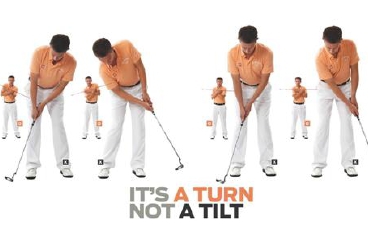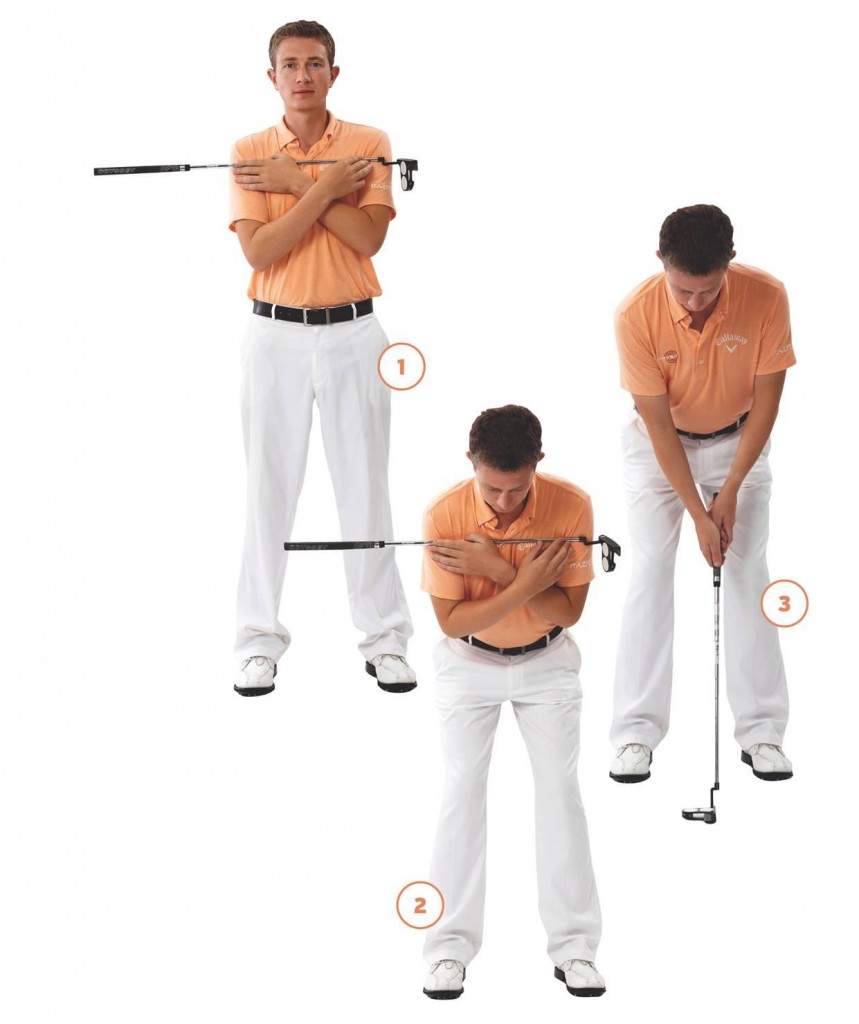Putting Stroke Technique: Turn vs Tilt
Golf tips
Here’s one of the most common faults I see in putting. Players of all levels think that they must TILT their shoulders rather than TURN their shoulders. Even if you think this is not your fault, try these exercises.
You might start to feel differences to your normal movement. This would indicate that you are not moving your shoulders correctly.
Exercise
Stand up straight placing a club or shaft across your shoulders and follow these instructions.
TILT (Wrong)
 First, try TILTING your shoulder. Move your shoulders up and down with no rotation. To make sure you are doing this correctly, stand against a wall. When you are tilting with no rotation, both ends of the club should be moving parallel to the wall. Do you notice how it is nearly impossible to keep you head still, and how unnatural a move it is? Your body is simply not designed to have and big range of movement with this tilting action. You can maybe move your shoulders a few inches, but any more and your spine and head will have to start moving to accommodate. How many players have you seen that cannot keep their head still? Fair chance this is their fault.
First, try TILTING your shoulder. Move your shoulders up and down with no rotation. To make sure you are doing this correctly, stand against a wall. When you are tilting with no rotation, both ends of the club should be moving parallel to the wall. Do you notice how it is nearly impossible to keep you head still, and how unnatural a move it is? Your body is simply not designed to have and big range of movement with this tilting action. You can maybe move your shoulders a few inches, but any more and your spine and head will have to start moving to accommodate. How many players have you seen that cannot keep their head still? Fair chance this is their fault.
TURN (Right)
- Now, in the same position standing up, rotate your shoulders to the left and then to the right. You will have to step away from the wall to make this possible. Do you notice how easy it is to keep your head still and how comfortable it is for your body to move in this way?
“This is the way your shoulders must work during the stroke no matter what path you want your putter head to move on”
Apply this to your stroke
My personal belief is there is nothing difficult about making a good stroke no matter what standard of player you are. If you have a good concept, your stroke can be as good as anyone’s in the world. You may not be able to have a Rory Mcilroy golf swing, but you can have his putting stroke! Applying this movement is very simple.
Exercises
- The exercise above, where you are standing up, is the starting point; practice this drill for 5 – 10 reps, developing the feel for the correct shoulder movement.
- After you have a feeling for the movement, move forward into your putting posture and repeat the same movement.
- Again, once you have the feeling in your putting address with the correct shoulder rotation, let your arms drop and take hold of your putter. You should, by now, be able to feel your shoulder movement controlling the stroke with a TURN not a TILT!
Posture controls the path not the shoulders
Some of you will know that in putting there are 2 different concepts for the path the putter should move on. Some teachers / players believe the putter head should travel on a straight line during the whole stroke, where as, others believe it should travel on an arch, inside to straight to inside. Personally, I believe they can both work. Both methods have been used very successfully by great putters. There have been major champions with both, so, to me, the most important thing is you choose one and believe in it. If you are a player that wants to move the putter head on a straight line, you might be asking how can I do that by TURNING my shoulders?
The important point to understand this movement is that you achieve your desired path by not changing the way your shoulders move as so many do, but by adjusting your posture at address. As I have said, your shoulders must turn in the stroke no matter what kind of stroke you want. Different postures will create different putter paths; you can turn with both.
Straight to Straight Address Posture
 In this posture, you can see my upper spine and back of my neck are close to parallel to the ground, with my arms hanging below my shoulders. From this posture, if I turn my shoulders, the putter will travel close to straight to straight.
In this posture, you can see my upper spine and back of my neck are close to parallel to the ground, with my arms hanging below my shoulders. From this posture, if I turn my shoulders, the putter will travel close to straight to straight.
Inside to Inside Address Posture
- In this posture, you can see my upper spine and back of neck are above parallel to the ground. From this posture, if I turn my shoulders, the putter path will travel inside on the back swing, to square at impact, and inside in the follow through.

